A few kilometers northeast of
Kostrzyn (Küstrin) is the battlefield of one of the
bloodiest battles of the 18th Century. The so-called Seven Years' War
(also known as Third Silesian War) were was fighting Prussia and
United Kingdom / Kurhannover against Austria, France and Russia.
Near the small villige Zorndorf, now
Sarbinowo, met in the summer of 1758
armies of the Prussian king Friedrich the Great and the Russian Empress Elisabeth
under their commander, Count William Fermor at a battle.
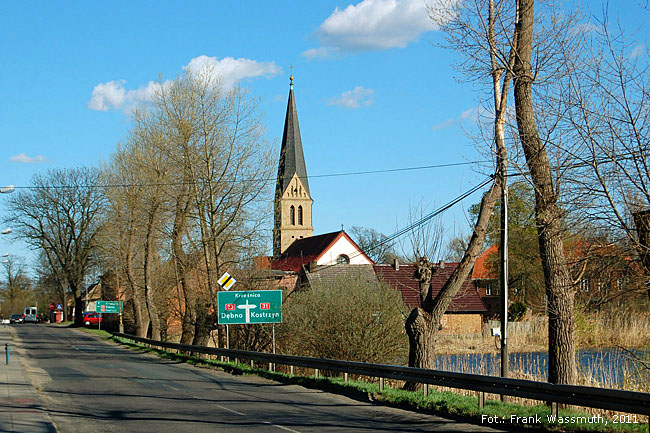
Zorndorf (Sarbinowo) in the year 2011
The battle was preceded by the occupation of East Prussia by Russia. From the south threatened
the Austrians, Prussians, the situation for the Prussian king was much
threatening. The king himself was at least concerned that things would turn out well, and delivered
precaution, his minister, Count Karl Wilhelm von Finck Finckenstone in a secret instruction
the affairs of state in case of his own death or his capture.
In the relevant part of the Neumark, a Russian force of nearly 45,000 men stood ready, equipped
with nearly 400 cannons.
In a forced march Friedrich tried to get to the river Odra. On 20 August 1758 he came to
Frankfurt/Oder, where he could see the first signs of war, the bombardment of the
city Küstrin by the Russians.
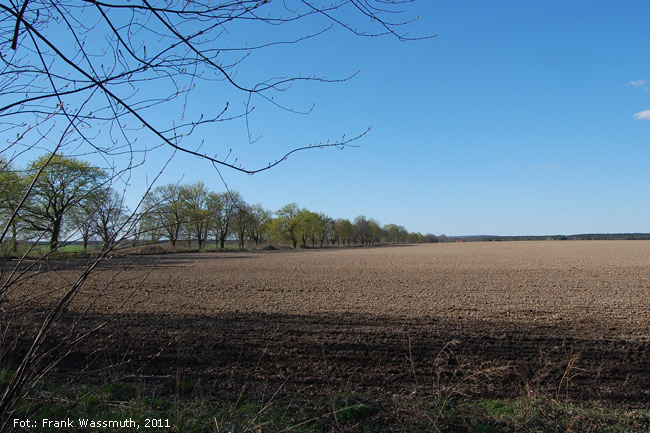
The battlefield of the Zorndorf battle
in the year 2011
Küstrin is an eloquent example that history repeats itself often. In
2nd World War 1945 totally exterminated, it was in 1758 when the city already in an act of war
was almost completely destroyed.
There was no protection for the civilian population in 1758, this was absolutely in the
hand of the warring parties.
The prelude to the battle following in a few days was an artillery attack on 20 August 1758
up to the town and fortress Küstrin. Russian troops advanced on the fortress and the city
Küstrin, but destroyed most civilian targets.
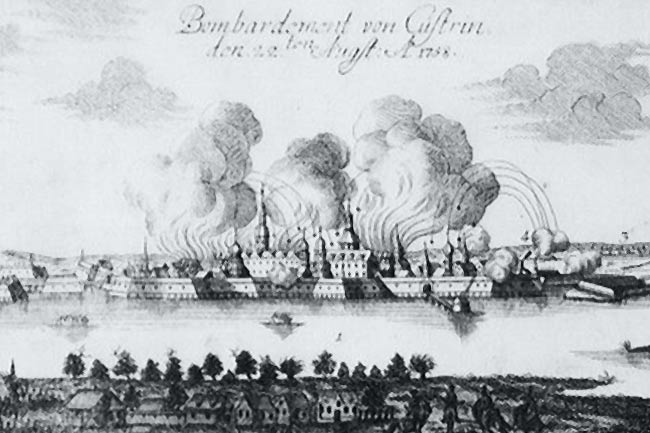
Bombing of Küstrin (Contemporary
picture from 1759)
In the book "Special sights and stories from Neudam (sic!) in the Neumark and
the area around at the unfortunately presence of the Russian Imperial Army"
describes a (unfortunately not known by name) vicar as a witness in a
official documentation directed to a collegue the events in the summer days 1758.
There was a accurate and very impressive description of the events surrounding
the Battle of Zorndorf, even if the title of this work do not suppose it can be.
"Today at 8 clock began our hearts to shake and tremble at our homes.
There was starting the most dreadful cannonade, which was made on both sides to Cüstrin.
Even after half an hour went up a huge smoke and fire blight 28 hours
like an burning oven."
"In the city itself is not one private house standing, only the garrison church used as
a hospital is standing yet and the stick house are the pitiful ruins of the city;
And this by the cause, because they are actually in the wall. On the walls of the fortress
but no stone has been touched."
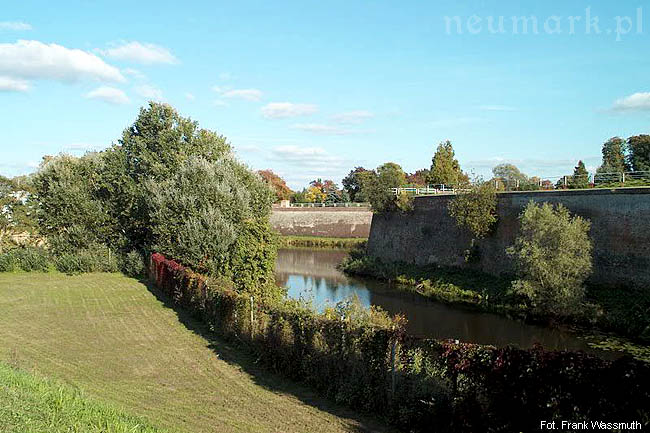
Fortress and city Küstrin
had suffered severely in 1758.
The bombardment had destroyed mainly civilian buildings, as they largely still in timber
were built, the fortress and city walls were apparently largely intact in 1758.
Even then, there was not only human suffering and damage to buildings to complain,
as later in the 2nd World War there were irreplaceable cultural heritage destroyed in considerable quantity.
"The Royal Treasury and the Berlinische Arsenal, the royal crown, the Prussian
Archive, the very best things of gold and silver, even the church equipment from the Neumark
and ours too were safe in this fortress. All this is now destroyed by the fire, all
is burned by the blaze."
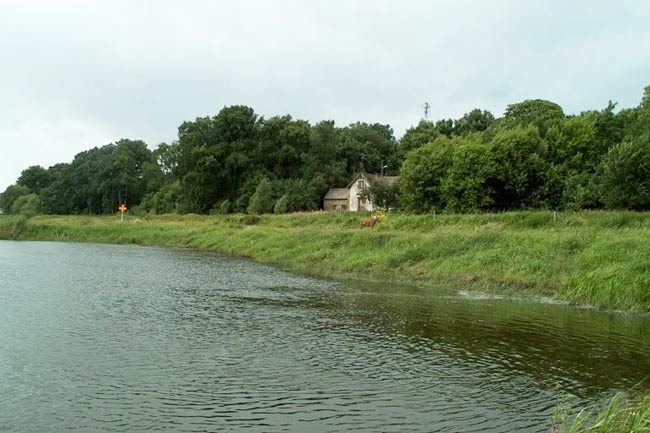
Güstebiese (Gozdowice) at the river Odra.
Not far from this place Friedrich put its
troops across the river.
The Prussian troops marched on 21 August from village Gorgast in a clever
evasive movement to Güstebiese (
Gozdowice), where they gone across the river Odra
by an temporary bridge.
To distract the enemy, which was waiting behind Küstrin, they also built a bridge there, and attracted
with a feint impression that the transition will happen there. The prepared russian 150
cannons were waiting for nothing.
In Güstebiese (
Gozdowice), the king was received enthusiastically.
Georg Friedrich von Tempelhoff, as a soldier also witness of the event (later he would
Lieutenant-General and the author of important military history books), described it this way:
"While the king was at the height of the hill he was received from people (which had
extraordinarily suffered by the Russians), especially of peasant women and children from Güstebiese surrounded, which
called him her father, her rescuer, and which tried to kiss his coat, crashed to each other soon."
After a night in Clossow on the estate of Herrn von Morner the king and his troops moved to
Darmiezel (Dargomysl) before he spent the night in the Neudamm (
Dębno) mill on the Mietzel (Mysla).
The forestry official Zöllner had to serve him as a guide on the next day, so the king had the advantage
of local knowledge. Here also the King's highly developed skills of its pioneers helped,
which erected two temporary bridges over the river Mietzel on the place of the destroyed by the Russians one,
to accelerate the advance of his troops at the next morning.
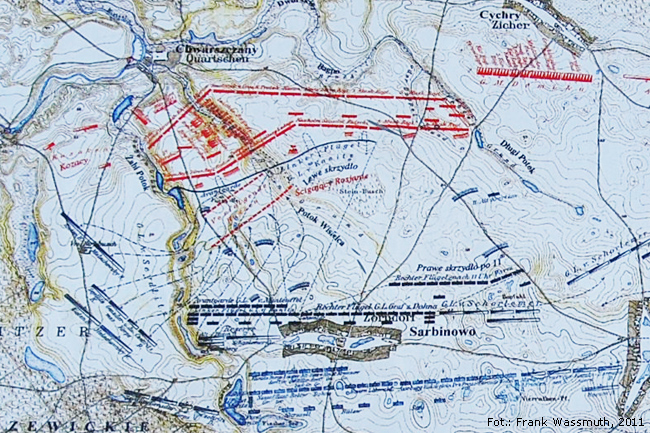
Map of the Zorndorf battle,
Prussian forces blue, russian red.
On 25 August 1758, as the past few days a hot summer day, the king leaves the mill about 3.30
clock in the morning pull his army into battle. In the fields between Quartschen (
Chwarszczany), Zorndorf (
Sarbinowo), Zicher (
Cychry)
and Wilkersdorf (
Krześnica) the king had circumvented the Russian troops and attacks now.
The usual and often successful first attack of the prussian infantry brings only little
success, the battle seems to be bogged down. The left prussian wing had to retreat,
the situation looks threatening. Friedrich personally intervened, dismounted and
took the flag of the retreating infantry regiment in the hand and led the already
fleeing troops back into battle (an image of this day - by many painters
immortalized: Friedrich, with the flag, leading its
men into the battle. Do the reality really looked like that?).
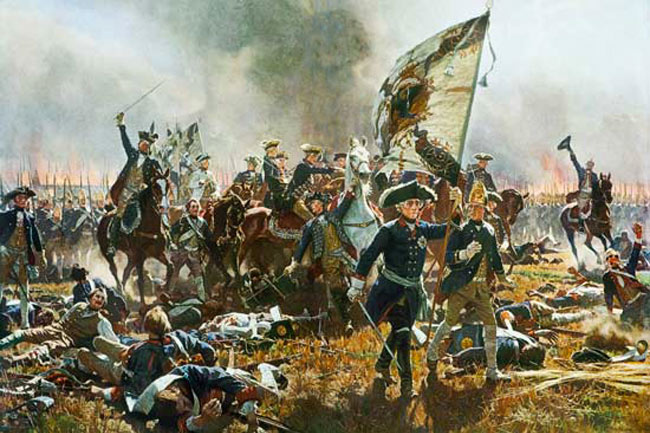
Friedrich the Great in the battle of Zorndorf,
Carl Röchling (1904)
However, the decision was not brought by Friedrichs personal action, but
by the insubordination of one of his commanding officers, the young lieutenant general
Friedrich Wilhelm von Seydlitz-Kurzbach.
The order of the king, to attack with his cavalry the center of the storming Russians,
he denied this several times, although the king threatened him with the
words "he would be responsible with his head for the outcome of the battle". Seydlitz-Kurzbach
opposed by saying "Tell the king, after the battle my head is to its service,
in the battle, he must allow me still to use it for him."
The young, smart cavalry general waits and lets the
opponents storm at first, until he attacked then with its squadrons from behind
and saved the outcome of the battle and - certainly also saved his own head.
He drove back the Russian troops and rubbed a great part of them in the morass of Quartschen
(
Chwarszczany).
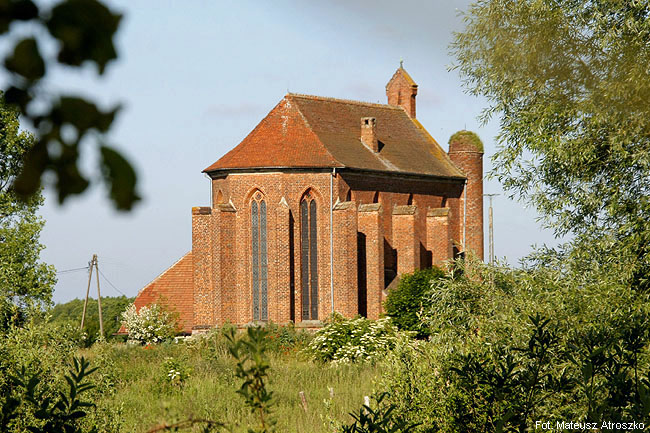
The chapel of Quartschen. Here was the
retreat of the russian forces.
The king paid tribute to Seydlitz-Kurzbach after the end of the battle. He said to the ambassador of its British allies
"Without this here it would be bad for us today".
It seems that he was not infuriated by the "creative interpretation of its order" by its general, and
finally Seydlitz-Kurzbach made further career and was inspector general of silesian cavalry and
general of the royal cavalry.
Seydlitz-Kurzbach is with its kind of command performance today a model of the german
army; barracks and ships were named after him, he fulfilled the command of the king
from his mind, not from its form - an unprecedented act in Prussia, now base
of modern military leadership. The family Seydlitz-Kurzbarch stayed connected with military,
a descendant of the cavalry general, Walther von Seydlitz-Kurzbach fell, as a highly decorated general
1943 in Stalingrad in captivity and seemed, like his ancestor, pragmatic action
preferable, but unfortunately unsuccessful: As a member of the BDO (Association of German
Officers), he sat down for an end of the war with the Soviet Union and was fighting against National Socialism.
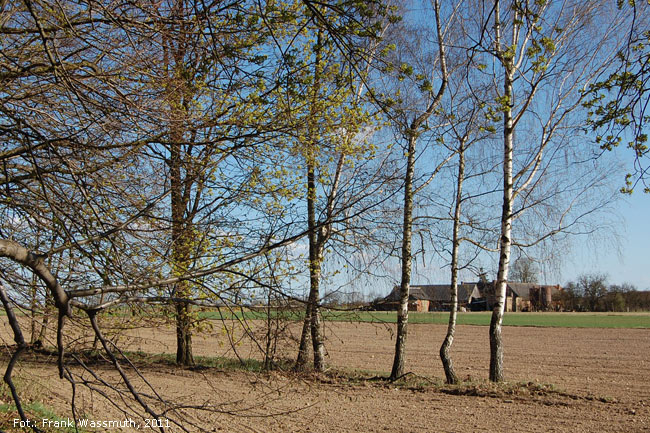
On the battlefield of Zorndorf 2011
"The battle began at 9 clock in the morning and ended 8 ˝ Clock evening. The king wins out over
Russians under Fermor. This lost 941 officers, including five generals, and 20590 man
killed, wounded and prisoners, 103 cannons and 27 flags and banners, a pair
drums and a lot of baggage. The Prussian loss was in 324 officers,
11061 men, 26 guns and some flags. The strength of the Prussian army on the day of
Battle was 30-32000 man , the Russian about 50000 men."
Karl Heinrich Siegfried Roedenbeck wrote later in his "Diary of Frederick the Great
regents life" about this day.
The king himself reported to his minister of Finckenstein: "We have just the Russians
beaten. The Bataille lasted 9 hours, and has been very bloody ..."
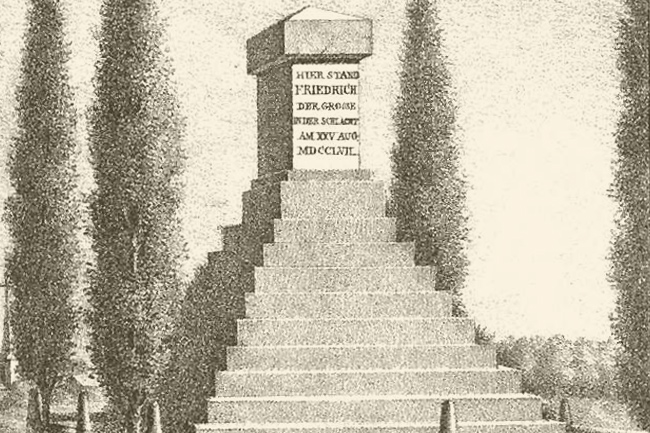
Memorial for the battle of Zorndorf,
errected in 1826, destroyed 1945
The King nor the others had understated. The battle has about 30000 soldiers on
both sides claimed their lives, not counted the wounded and civilian victims.
Numerous towns and villages were destroyed, destroyed stores of the farmers was a long term
follow of the war.
But in the villages and towns around the battlefield cames now, that they were happy to
had escaped from the struggle, the consequences of war.
The description of the vicar from Neudamm (
Dębno) offers a realistic look behind the
heroic battle scenes of the history books.
The cleaning of the battle field and care of the wounded and the prisoners remained
was a matter for the local population, which itself was suffered so much in the event.
Yet for days, even weeks they own and other wounded soldiers was in the crowded
villages and cities.
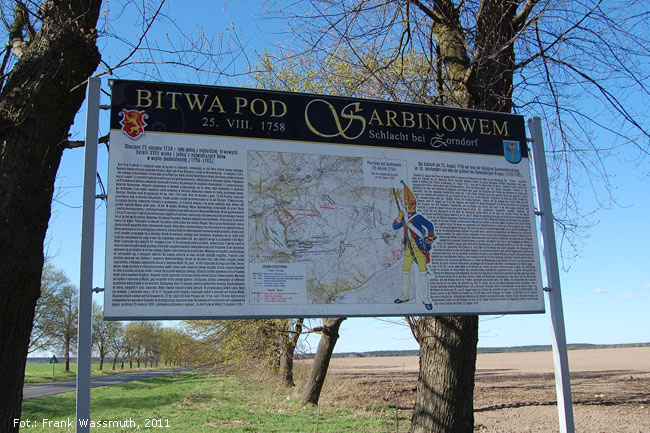
Information board at the battlefield
"My God, what were there people! ... a great morass, called Haagebruch.
In this unfortunate death valley down from the top down-covered carriages, packaging, setup,
provisions, powder and other cars cast down into the run. Everything is wrong with each other
and sunk. Six hundred Russians have at least found her grave in it, which partly shot dead,
some are drowned."
"In the ordinary field of battle was commonly a horse and 10 Russians together buried,
but the Prussians are buried especially . 30 men from our town, together with other ones from
the surrounding villages had to work 4 full weeks, to buried the deads. "
And even after the end of hostilities the bloodshed did not end. There was not a supply of
the injured, as known from modern wars, the wounded were still lying
weeks later on the battlefield around, while farmers and others looted them.
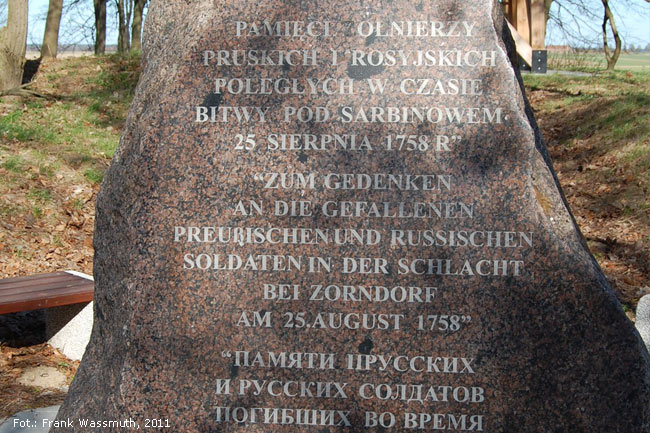
The new memorial for the battle of
Zorndorf, errected 2010
The vicar of Neudamm also reports of these:
"The Russians, who were still alive, were beaten on the head or shot dead by a hunter, who was commanded to do that, and buried."
"The fields were in corn, in the flax, behind the fences around us a great
amount of dead, half-eaten and rotten. The still living came to town and the villages
and asked for food; which could not get away, had to eat the bark on the trees,
so far as they can reach, and therefore they lived in the fourth week after the battle."
"People from Berlin and from Wrizen came to loot here, and being dragged for long after money,
copper, brass, tin, iron, silver, cars,
clothes, beds, food or baking, books, tents, paper, bedss, chairs,
hats, jacket, furs, shirts, boots, shoes and countless things away."
Descriptions of a chaotic war situation without law and order, where every man for himself is next.
Geneva Convention and Hague Regulations were developed until centuries later, but the events in the 2nd World War
to prove that regulations also make wars not really more human.
The Russian troops withdrew to the east, Friedrich had at least gained time. Despite his
Victory seemed already clear that for him it was only a temporary profit, the next fight
was already emerging.
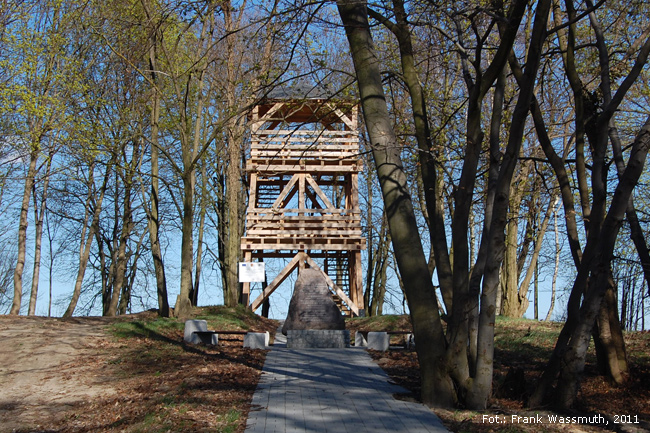
The so-called Friedrichs Hill with memorial
and observation tower 2011
On 25 August 1826 established the citizens of the area on the so-called Friedrich hill near Zorndorf (
Sarbinowo)
a monument to the battle. The monument was pretty easy held in the form of a pyramid with an above oblong with the words "Here
was Friedrich the Great standing in the Battle of the XXV. Aug. MDCCLVIL."
For a lot of citizens the monument was not pompous enough.
As a result, it happened the written by Theodor Fontane in his "Walks through Brandenburg"
detained "stroke of genius":
The arts patron, Count of Schwerin, Lord of the village Tamsel (Dabroszyn), learned that in Küstrin a patriotic plumber
produced a sculpture of King Friedrich in tin plate and had decided, after he
had already made in the park of his palace in Tamsel (Dabroszyn) a beautiful Victorian sculpture of the artist Rauch,
to purchase it. In a cloak-and-dagger action the count brought the white metal figures on the obelisk.
Within the next year showed that the material faded and the once brilliant figure in mockery of the
neighboring farmers had become.
This harmed the Counts aesthetic conscience, and he let the figure secretly remove.
The monument stood in this form until 1945, then it was destroyed. In 2010, a new memorial stone, not only to the winner
of the battle, but to the fallen soldiers of both warring parties, was errected. Near the stone was a observation tower
built, which offers (unfortunately by the surrounding high trees) only in the wintertime views to the battlefield.
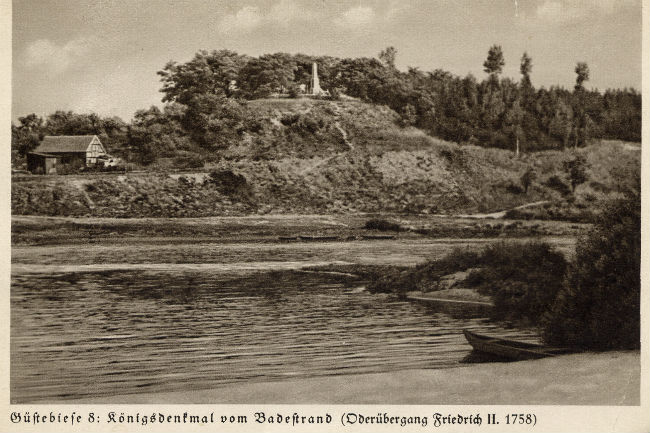
The 1945 destroyed monument for
Friedrichs transition of the Odra at
Güstebiese. Collection B. Atroszko.
Even near Güstebiese (
Gozdowice) was built in 1908 a memorial in the form of an obelisk, which remembers to the
Friedrichs transition of the Oder. The monument was destroyed in the 2nd World War.
The famous mill on the Mietzel (Mysla) is no longer existent. After the battle there was still, according to Fontanes book,
an armchair been kept there, where Friedrich slept at the night before the battle.
By the battle the surrounding villages Zorndorf, Quartschen, Wilkersdorf and others were affected, the following centuries
with more wars did the rest.
So there are not much architectural reminiscents still existent on the field of battle.
In Quartschen still stands the Temple Church, which offered in 1758 the Russian troops in their retreat a shelter, but the
most of the surrounding buildings have not survived.
However, a walk through the fields between Zorndorf (
Sarbinowo), Wilkersdorf (
Krześnica) and Quartschen (
Chwarszczany) with the knowledge
to the events in 1758 still is a good trip into a part of european history that may not repeat.
F. Wassmuth, 2011